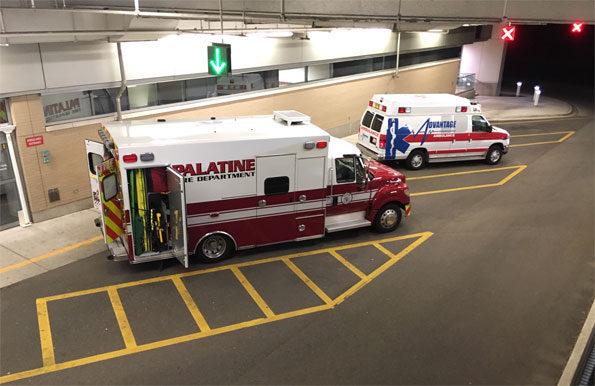Designation vs. Verification
Trauma center levels across the United States are identified in two fashions – A designation process and a verification process. The different levels (ie. Level I, II, III, IV or V) refer to the kinds of resources available in a trauma center and the number of patients admitted yearly. These are categories that define national standards for trauma care in hospitals. Categorization is unique to both Adult and Pediatric facilities.
Trauma Center designation is a process outlined and developed at a state or local level. The state or local municipality identifies unique criteria in which to categorize Trauma Centers. These categories may vary from state to state and are typically outlined through legislative or regulatory authority.
Trauma Center Verification is an evaluation process done by the American College of Surgeons (ACS) to evaluate and improve trauma care. The ACS does not designate trauma centers; instead, it verifies the presence of the resources listed in Resources for Optimal Care of the Injured Patient. These include commitment, readiness, resources, policies, patient care, and performance improvement.
This is a voluntary process by the Trauma Center being verified and lasts for a 3-year period.
Trauma Center Levels
As mentioned above, Trauma categories vary from state to state. Outlined below are common criteria for Trauma Centers verified by the ACS and also designated by states and municipalities. Facilities are designated/verified as Adult and/or Pediatric Trauma Centers. It is not uncommon for facilities to have different designations for each group (ie. a Trauma Center may be a Level I Adult facility and also a Level II Pediatric Facility).
Level I
Level I Trauma Center is a comprehensive regional resource that is a tertiary care facility central to the trauma system. A Level I Trauma Center is capable of providing total care for every aspect of injury – from prevention through rehabilitation.
Elements of Level I Trauma Centers Include:
24-hour in-house coverage by general surgeons, and prompt availability of care in specialties such as orthopedic surgery, neurosurgery, anesthesiology, emergency medicine, radiology, internal medicine, plastic surgery, oral and maxillofacial, pediatric and critical care.
Referral resource for communities in nearby regions.
Provides leadership in prevention, public education to surrounding communities.
Provides continuing education of the trauma team members.
Incorporates a comprehensive quality assessment program.
Operates an organized teaching and research effort to help direct new innovations in trauma care.
Program for substance abuse screening and patient intervention.
Meets minimum requirement for annual volume of severely injured patients.
Level II
A Level II Trauma Center is able to initiate definitive care for all injured patients.
Elements of Level II Trauma Centers Include:
24-hour immediate coverage by general surgeons, as well as coverage by the specialties of orthopedic surgery, neurosurgery, anesthesiology, emergency medicine, radiology and critical care.
Tertiary care needs such as cardiac surgery, hemodialysis and microvascular surgery may be referred to a Level I Trauma Center.
Provides trauma prevention and continuing education programs for staff.
Incorporates a comprehensive quality assessment program.
Level III
A Level III Trauma Center has demonstrated an ability to provide prompt assessment, resuscitation, surgery, intensive care and stabilization of injured patients and emergency operations.
Elements of Level III Trauma Centers Include:
24-hour immediate coverage by emergency medicine physicians and the prompt availability of general surgeons and anesthesiologists.
Incorporates a comprehensive quality assessment program
Has developed transfer agreements for patients requiring more comprehensive care at a Level I or Level II Trauma Center.
Provides back-up care for rural and community hospitals.
Offers continued education of the nursing and allied health personnel or the trauma team.
Involved with prevention efforts and must have an active outreach program for its referring communities.
Level IV
A Level IV Trauma Center has demonstrated an ability to provide advanced trauma life support (ATLS) prior to transfer of patients to a higher level trauma center. It provides evaluation, stabilization, and diagnostic capabilities for injured patients.
Elements of Level IV Trauma Centers Include:
Basic emergency department facilities to implement ATLS protocols and 24-hour laboratory coverage. Available trauma nurse(s) and physicians available upon patient arrival.
May provide surgery and critical-care services if available.
Has developed transfer agreements for patients requiring more comprehensive care at a Level I or Level II Trauma Center.
Incorporates a comprehensive quality assessment program.
Involved with prevention efforts and must have an active outreach program for its referring communities.
Level V
A Level V Trauma Center provides initial evaluation, stabilization and diagnostic capabilities and prepares patients for transfer to higher levels of care.
Elements of Level V Trauma Centers Include:
Basic emergency department facilities to implement ATLS protocols
Available trauma nurse(s) and physicians available upon patient arrival.
After-hours activation protocols if facility is not open 24-hours a day.
May provide surgery and critical-care services if available.
Has developed transfer agreements for patients requiring more comprehensive care at a Level I through III Trauma Centers.
SUBJECT TO CHANGE WITHOUT NOTICE OR IMMEDIATE UPDATED INFORMATION
SOURCE:
American Trauma Society
Get updates from The Cardinal ALL NEWS FEEDS on Facebook. Just ‘LIKE’ the ‘Arlington Cardinal Page (become a fan of our page). The updates cover all posts and sub-category posts from The Cardinal — Arlingtoncardinal.com. You can also limit feeds to specific categories. See all of The Cardinal Facebook fan pages at Arlingtoncardinal.com/about/facebook …
Help fund The Cardinal Arlingtoncardinal.com/sponsor


 Amazon Best Sellers in Audible Books
Amazon Best Sellers in Audible Books